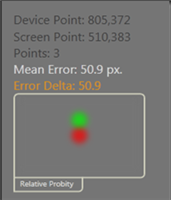Contents tagged with eye-tracking
-
26 Sep 2011

EventIDE provides a built-in calibration procedure for all supported eye-tracker models. The built-in GLM calibration is recommended, even if you calibrate your eye-tracker with native manufacturer tools. The GLM calibration procedure uses the least square linear method to fit the eye-tracker gaze positions to pixel coordinates on the screen. The linear fitting is done separately for X and Y signals and results in estimation of two pairs of coefficients of a General Liner Model: X Gain, X offset and Y gain and Y offset. The coefficients are applied into GLM equations (shown below) that are later used in EventIDE during runtime eye-tracking.
-
Tobii AddIn
This AddIn contains elements that enable Tobii-base eye-tracking for behavioral tasks designed with EventIDE.
Developed by and published on 27 May 2011
-
SMI AddIn
This AddIn contains a element that enables SMI-based eye-tracking for behavioral tasks designed with EventIDE.
Developed by and published on 27 May 2011
-
JazzNovo AddIn
This AddIn contains element that enables the JazzNovo eye-trackering for behavioral tasks designed with EventIDE.
Developed by and published on 27 May 2011
-
NI DAQ AddIn
This AddIn contains elements that allow an use National Instruments data acquisition cards in EventIDE for synchronization, data exchange and eye-tracking tasks.
Developed by and published on 27 May 2011
-
MC DAQ AddIn
This AddIn contains elements that allow using Measurement Computing data acquisition cards in EventIDE for synchronization, data exchange and eye-tracking tasks.
Developed by and published on 27 May 2011
-
EyeLink AddIn
This AddIn contains element that enables the EyeLink-based eye-tracking for behavioral tasks designed with EventIDE.
Developed by and published on 16 May 2011
